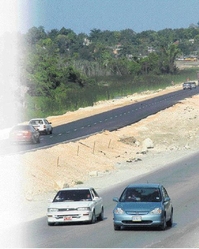Tourism fund taps $300 million for highway project - As NWA, parish council disclaim responsibility
Published: Wednesday | July 15, 2009

The stretch of the North Coast Highway from the Sangster International Airport to Flankers is seen at left while still under construction in March 2007. - File
Tourism Minister Edmund Bartlett is tapping the Tourism Enhancement Fund (TEF) for $300 million to spruce up the roadway in Rose Hall, encompassing a piece of the hotel strip within his East Central St James constituency.
The multimillion expenditure will provide lighting at $200 million and landscaping for another $100 million, covering the distance from the Montego Bay airport to The Iberostar hotel at Lilliput.
The stretch includes properties such as the luxury Ritz-Carlton, Half Moon and Sandals Royal Caribbean.
Street lighting and the tending of verges is normally a function of the local-planning authority but operators of the TEF are defending the work - on what it is selling as the creation of an 'elegant corridor' - as a safety issue though the funds are meant to enhance the tourism product.
Highway a hazard
"Ordinarily, it would be the National Works Agency or the parish council but none of them has the money to do it now and whilst they don't have the money to do it, more and more people are dying along the strip, we have to intervene," said TEF Chairman Godfrey Dyer.
The stretch to be beautified forms part of the eastern leg of MoBay leg of North Coast Highway on which construction was wrapped up about a year and a half ago.
Dyer is not the only one alleging that the highway is a hazard.
"From a safety point of view, a number of accidents have occurred there," said Omar Robinson, deputy chairman of the Montego Bay chapter of the Jamaica Hotel and Tourist Association.
That is why the TEF has given the money."
Robinson, though he said the deaths were "extremely" high, did not quantify the fatalities.
Nor did the TEF chairman.
"There are so many accidents that are happening there because it is dark, so it is very necessary and the people dying are Jamaicans, so it is very necessary," said Dyer.
Lighting important
"So to protect peoples' lives, it is important that the lighting be put in and to also complete the landscaping there."
Still others say that the hazard created by speeding motorists has already been addressed by the erection of a number of street lights along the strip, putting a check on speeding motorists and the accidents they caused.
Charles Sinclair, the mayor of Montego Bay and chairman of the St James Parish Council, also said that the majority of accidents occurred in the daytime, negating the argument that lighting was the answer.
"Accidents take place because many persons drive carelessly," said Sinclair.
"I have seen cars out there driving at close to a 100 miles per hour, way above the speed limit, way above the permit of their light ... don't blame that on lighting, blame that on poor judgement and poor driving skills."
The mayor acknowledged that street lighting is normally a parish council responsibility, but said it extends only to ensuring the lamps are lit and paying the electricity bills - not having them erected.
"Street-light infrastructure placement that is put up in any developed area is not the responsibility of the council," said Sinclair.
In this case, lighting the roadway would have fallen to road developer National Works Agency (NWA), he said, as the entity responsible for constructing the highway.
In that regard, the financing should have emanated from the Mike Henry-led Ministry of Transport, and not the tourism ministry.
On Tuesday, NWA also denied it was responsible for the lights.
"The floodlights along the corridor, I am being told that those were not part of our responsibility. That responsibility was left with the Tourism Product Development Company (TPDCo)," said Stephen Shaw, NWA manager of communication and customer service.
"The infrastructure of the traffic signals that is what we focus on. The floodlights, that is purely up to JPS, we don't get involve in those and TPDCo is the lead agency with responsibility for that."
The TEF was established in 2005 with the primary role of funding projects earmarked for execution in the Tourism Master Plan, which is aimed at enhancing Jamaica's image and positioning the country as a premier tourist destination.
Dyer said the allocation of the funds for the highway corridor falls within the remit of the fund.
"It enhances the tourism project, anything that enhances the tourism project is within its purview. Apart from making it beautiful, it will also be making it safer," he said.
Tourism Minister Bartlett said the intention is to transform the stretch of land into "a thing of beauty that will attract both visitors and citizens."
"What you will really see is a beautiful corridor, which will be aesthetically pleasing and would create a destination pretty much like South Beach in Florida. That is an area of high value that visitors will come to and pay higher rates to be," he said.
"Along that corridor, you have all the top-end properties in the Montego Bay area. You are going to have the convention centre there, that is where you have the White Witches Golf Course ... The Rose Hall Great House, that's where you have the Ritz-Carlton, the Iberostar, Half Moon," he said.
The $200 million will pay Jamaica Public Service Company, which will provide and erect the poles for the street lights.
The job is expected to take three months.
"We are expecting that this will be completed by the winter tourism season," said Bartlett.
The season begins December 15 each year.
dionne.rose@gleanerjm.com





















